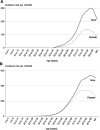Parkinson's Disease Is Predominantly an Environmental Disease
- PMID: 38217613
- PMCID: PMC11091623
- DOI: 10.3233/JPD-230357
Parkinson's Disease Is Predominantly an Environmental Disease
Abstract
Parkinson's disease is the world's fastest growing brain disorder, and exposure to environmental toxicants is the principal reason. In this paper, we consider alternative, but unsatisfactory, explanations for its rise, including improved diagnostic skills, aging populations, and genetic causes. We then detail three environmental toxicants that are likely among the main causes of Parkinson's disease- certain pesticides, the solvent trichloroethylene, and air pollution. All three environmental toxicants are ubiquitous, many affect mitochondrial functioning, and all can access humans via various routes, including inhalation and ingestion. We reach the hopeful conclusion that most of Parkinson's disease is thus preventable and that we can help to create a world where Parkinson's disease is increasingly rare.
Keywords: Parkinson disease; genetics; indoor air pollution; mitochondria; pesticides; primary prevention; solvents; tetrachloroethylene; trichloroethylene; water pollution.
Conflict of interest statement
Dr. Dorsey has received honoraria for speaking at American Academy of Neurology, American Neurological Association, Excellus BlueCross BlueShield, International Parkinson’s and Movement Disorders Society, National Multiple Sclerosis Society, Northwestern University, Physicians Education Resource, LLC, PRIME Education, LLC, Stanford University, Texas Neurological Society, and Weill Cornell; received compensation for consulting services from Abbott, Abbvie, Acadia, Acorda, Bial-Biotech Investments, Inc., Biogen, Boehringer Ingelheim, California Pacific Medical Center, Caraway Therapeutics, Curasen Therapeutics, Denali Therapeutics, Eli Lilly, Genentech/Roche, Grand Rounds, Huntington Study Group, Informa Pharma Consulting, Karger Publications, LifeSciences Consultants, MCM Education, Mediflix, Medopad, MedRhythms, Merck, Michael J. Fox Foundation, NACCME, Neurocrine, NeuroDerm, NIH, Novartis, Origent Data Sciences, Otsuka, Physician’s Education Resource, Praxis, PRIME Education, Roach, Brown, McCarthy & Gruber, Sanofi, Seminal Healthcare, Spark, Springer Healthcare, Sunovion Pharma, Theravance, Voyager and WebMD; research support from Biogen, Biosensics, Burroughs Wellcome Fund, CuraSen, Greater Rochester Health Foundation, Huntington Study Group, Michael J. Fox Foundation, National Institutes of Health, Patient-Centered Outcomes Research Institute, Pfizer, PhotoPharmics, Safra Foundation, and Wave Life Sciences; editorial services for Karger Publications; stock in Included Health, stock in Mediflix and ownership interests in SemCap.
Prof. Bloem currently serves as co-Editor in Chief for the
Figures


Similar articles
-
Trichloroethylene: An Invisible Cause of Parkinson's Disease?J Parkinsons Dis. 2023;13(2):203-218. doi: 10.3233/JPD-225047. J Parkinsons Dis. 2023. PMID: 36938742 Free PMC article. Review.
-
Environmental Risk Factors for Parkinson's Disease: A Critical Review and Policy Implications.Mov Disord. 2025 Feb;40(2):204-221. doi: 10.1002/mds.30067. Epub 2024 Nov 27. Mov Disord. 2025. PMID: 39601461 Free PMC article. Review.
-
Preventing Parkinson's Disease: An Environmental Agenda.J Parkinsons Dis. 2022;12(1):45-68. doi: 10.3233/JPD-212922. J Parkinsons Dis. 2022. PMID: 34719434 Free PMC article. Review.
-
The industrial solvent trichloroethylene induces LRRK2 kinase activity and dopaminergic neurodegeneration in a rat model of Parkinson's disease.Neurobiol Dis. 2021 Jun;153:105312. doi: 10.1016/j.nbd.2021.105312. Epub 2021 Feb 23. Neurobiol Dis. 2021. PMID: 33636387 Free PMC article.
-
Pesticides and Parkinson's disease.Biomed Pharmacother. 1999 Apr;53(3):122-30. doi: 10.1016/S0753-3322(99)80077-8. Biomed Pharmacother. 1999. PMID: 10349500 Review.
Cited by
-
Differential methylation of SNCA and MAPT genes associated with Parkinson's disease in Mexican Mestizos.Front Aging Neurosci. 2025 Jul 9;17:1612544. doi: 10.3389/fnagi.2025.1612544. eCollection 2025. Front Aging Neurosci. 2025. PMID: 40703677 Free PMC article.
-
Large-scale copy number variant analysis in genes linked to Parkinson´s disease.NPJ Parkinsons Dis. 2025 Aug 1;11(1):225. doi: 10.1038/s41531-025-01076-y. NPJ Parkinsons Dis. 2025. PMID: 40750593 Free PMC article.
-
Longitudinal assessment of the association between pesticide exposure and lifestyle with Parkinson's disease motor severity.NPJ Parkinsons Dis. 2025 Jun 12;11(1):164. doi: 10.1038/s41531-025-01010-2. NPJ Parkinsons Dis. 2025. PMID: 40506444 Free PMC article.
-
Parkinson's Disease Pathogenic Variants: Cross-Ancestry Analysis and Microarray Data Validation.medRxiv [Preprint]. 2024 Dec 17:2024.12.16.24319097. doi: 10.1101/2024.12.16.24319097. medRxiv. 2024. PMID: 39763553 Free PMC article. Preprint.
-
Protecting Your Health and Brain Against Climate Change: An Information Page for Older Adults.Arch Phys Med Rehabil. 2025 May;106(5):813-816. doi: 10.1016/j.apmr.2025.01.418. Epub 2025 Feb 5. Arch Phys Med Rehabil. 2025. PMID: 39918531 No abstract available.
References
-
- Parkinson J (2002) An essay on the shaking palsy.1817. J Neuropsychiatry Clin Neurosci 14, 223–236; discussion 222. - PubMed
-
- Dorsey R, Sherer T, Okun MS, Bloem BR(2020) Ending Parkinson’s Disease: A Prescription for Action, Public Affairs.
MeSH terms
Substances
LinkOut - more resources
Full Text Sources
Medical

